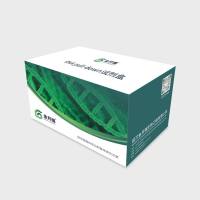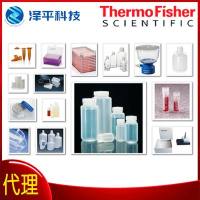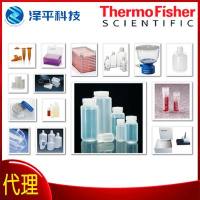Spectroscopic Methods for the Determination of Protein Interactions
互联网
- Abstract
- Table of Contents
- Materials
- Figures
- Literature Cited
Abstract
This unit provides guidelines on how to use steady?state fluorescence spectroscopy for the quantification of protein?protein interactions. The fluorescence of a protein is characterized by its excitation and emission spectra, quantum yield, and anisotropy. These parameters can change upon interaction with another protein and can be used to measure the extent of complex formation. The source of fluorescence can be an intrinsic fluorophore, such as tryptophan or tyrosine; a covalently attached fluorescent dye; or a fluorescent binding partner, such as a nucleotide or cofactor, that interacts specifically with the complex. Protocols are provided in this unit for determining affinity constants and stoichiometry values for protein?protein interactions using equilibrium titration experiments. In addition, fluorescent labeling of proteins is discussed, and an introduction to data analysis is provided. Most of the topics addressed in this unit can easily be applied to other spectroscopic methods or to the analysis of protein?ligand interactions.
Table of Contents
- Strategic Planning
- Basic Protocol 1: Fluorescence Titration to Monitor Complex Formation and Determine Binding Constants
- Basic Protocol 2: Introduction of a Fluorescent Label into a Protein and Determination of the Degree of Labeling
- Basic Protocol 3: Analysis of Titration Experiments: Determination of Binding Affinity and Stoichiometry
- Support Protocol 1: Determination of Optimal Emission and Excitation Wavelengths for Fluorescence Titration Experiments
- Support Protocol 2: Determination of the Stability and Propensity for Photobleaching of a Fluorescent Protein
- Commentary
- Literature Cited
- Figures
- Tables
Materials
Basic Protocol 1: Fluorescence Titration to Monitor Complex Formation and Determine Binding Constants
Materials
Basic Protocol 2: Introduction of a Fluorescent Label into a Protein and Determination of the Degree of Labeling
Materials
Basic Protocol 3: Analysis of Titration Experiments: Determination of Binding Affinity and Stoichiometry
Materials
Support Protocol 1: Determination of Optimal Emission and Excitation Wavelengths for Fluorescence Titration Experiments
Materials
|
Figures
-
Figure 20.8.1 Changes in fluorescence intensity and emission maximum wavelength (λmax ) upon complex formation. Compound S (gray line) does not contain tryptophan and thus does not contribute any fluorescence signal between 330 and 360 nm. Addition of compound S to protein A (dashed line), which contains five tryptophan residues, leads to an approximately twofold increase in fluorescence intensity and a shift in the fluorescence maximum from 335 nm to 328 nm upon complex formation (black solid line). AU, arbitrary units. View Image -
Figure 20.8.2 Binding curve as inferred from changes in the fluorescence maximum. A simulated binding curve constructed using saturation values (solid circles) is compared with a “binding curve” generated using the observed change in λmax (open circles). Full saturation is normalized to 1. The simulated spectra on which the determination of λmax is based are shown in Figure . The change in λmax due to complex formation is not linear and thus cannot be used to represent the true binding curve. View Image -
Figure 20.8.3 Fluorescence emission spectra of 10 µM tryptophan and 10 µM tyrosine at excitation wavelengths (λex ) of 280 and 295 nm. AU, arbitrary units. View Image -
Figure 20.8.4 Typical fluorescence titration data for a protein‐protein interaction. Protein S was added in stepwise fashion to a solution of protein A (0.9 µM). The relative fluorescence signal ( F [S] / F [S]=0 ) is plotted against the concentration of protein S. Binding of protein S quenches the fluorescence of protein A, which results in a decrease in signal. However, the relative change in fluorescence is only 17%, due to the presence of tryptophan residues not affected by the interaction. AU, arbitrary units. View Image -
Figure 20.8.5 Effect of the fluorescence of compound S on binding data. Simulated data for the addition of S to a solution originally containing 15 µM protein A ( K d = 5 µM, p = 1) are shown. Fluorescence is plotted against the concentration of compound S. In the simplest case, the fluorescence signal arises only from protein A (squares). If compound S also contributes to the fluorescence signal (solid circles), a nonhyperbolic total fluorescence curve is observed (open circles). In order to correct for the contribution of S, linear regression of the data obtained in the absence of protein A is performed, and the results of the regression are subtracted from the raw binding data. Abbreviations: AU, arbitrary units; C s , total concentration of compound S. View Image -
Figure 20.8.6 Quadratic binding curve and dilution effects. Typical experimental data were simulated for a case in which analysis based on a quadratic function was warranted. Black circles represent raw data, and triangles represent the data after correction for dilution. Curves correspond to the fits as discussed in the text. AU, arbitrary units. View Image -
Figure 20.8.7 Hyperbolic binding curve and dilution effects. Typical experimental data were simulated for a case in which analysis based on a hyperbolic function was warranted ([A] < 0.1 K d ). Black circles represent raw data, and triangles represent the data after correction for dilution. AU, arbitrary units. View Image -
Figure 20.8.8 Schematic representation of a protein‐protein interaction. Protein S binds to protein A, which is fluorescently labeled. Upon binding, the spectral properties and intensities of the emitted fluorescence change. View Image -
Figure 20.8.9 Simulated fluorescence spectra as might be observed in a titration experiment (fluorescence in arbitrary units, AU). Note the isosbestic point, where both spectra show the same fluorescence intensity. The existence of an isosbestic point indicates that only two interconverting fluorescent species (protein and complex) are present. View Image -
Figure 20.8.10 Spectral requirements for fluorescence resonance energy transfer (FRET). Schematic excitation (dotted) and emission (solid) spectra for a donor species (gray) and an acceptor species (black) are shown. The region of spectral overlap is shaded. AU, arbitrary units. View Image -
Figure 20.8.11 Monitoring of complex formation using FRET. A schematic representation of the use of FRET to monitor the formation of a complex between protein A and compound S is shown. (A ) Assume that compound S is labeled with a donor molecule (grey) and that protein A is labeled with an acceptor molecule (black). (B ) In a solution in which both S and A are present but do not interact, irradiation with a wavelength corresponding to the excitation maximum for the donor leads to fluorescence of the donor, but to much less (if any) fluorescence of the acceptor (depending on its excitation spectrum). (C ) However, when a complex between S and A is formed, such that the distance between acceptor and donor becomes small enough to allow FRET, the fluorescence of the donor decreases and the fluorescence of the acceptor increases. AU, arbitrary units. View Image
Videos
Literature Cited
| Solomon, M. and Stansbie, D. 1984. A coupled fluorometric rate assay for pyruvate dehydrogenase in cultured human fibroblasts. Anal. Biochem. 141:337‐343. | |
| Bai, Y., Perez, G.M., Beechem, J.M., and Weil, P.A. 1997. Structure‐function analysis of TAF130: Identification and characterization of a high‐affinity TATA‐binding protein interaction domain in the N terminus of yeast TAF(II)130. Mol. Cell. Biol. 17:3081‐3093. | |
| Becker, C.F., Hunter, C.L., Seidel, R., Kent, S.B., Goody, R.S., and Engelhard, M. 2003. Total chemical synthesis of a functional interacting protein pair: The protooncogene H‐Ras and the Ras‐binding domain of its effector c‐Raf1. Proc. Natl. Acad. Sci. U.S.A. 100:5075‐5080. | |
| Cornea, A. and Conn, P.M. 2002. Measurement of changes in fluorescence resonance energy transfer between gonadotropin‐releasing hormone receptors in response to agonists. Methods 27:333‐339. | |
| Hiratsuka, T. 1998. Prodan fluorescence reflects differences in nucleotide‐induced conformational states in the myosin head and allows continuous visualization of the ATPase reactions. Biochemistry 37:7167‐7176. | |
| Hutnik, C.M., MacManus, J.P., Banville, D., and Szabo, A.G. 1991. Metal‐induced changes in the fluorescence properties of tyrosine and tryptophan site‐specific mutants of oncomodulin. Biochemistry 30:7652‐7660. | |
| Jezewska, M.J. and Bujalowski, W. 1997. Quantitative analysis of ligand‐macromolecule interactions using differential dynamic quenching of the ligand fluorescence to monitor the binding. Biophys. Chem. 64:253‐269. | |
| Johnson, D.A., Leathers, V.L., Martinez, A.M., Walsh, D.A., and Fletcher, W.H. 1993. Fluorescence resonance energy transfer within a heterochromatic cAMP‐dependent protein kinase holoenzyme under equilibrium conditions: New insights into the conformational changes that result in cAMP‐dependent activation. Biochemistry 32:6402‐6410. | |
| Kelly, R.C. and von Hippel, P.H. 1976. DNA “melting” proteins: III: Fluorescence “mapping” of the nucleic acid binding site of bacteriophage T4 gene 32‐protein. J. Biol. Chem. 251:7229‐7239. | |
| Lakowitz, J.R. 1999. Principles of Fluorescence Spectroscopy. Kluwer Academic/Plenum Publishers, New York. | |
| LeTilly, V. and Royer, C.A. 1993. Fluorescence anisotropy assays implicate protein‐protein interactions in regulating trp repressor DNA binding. Biochemistry 32:7753‐7758. | |
| Li, Q., Du, H.N., and Hu, H.Y. 2003. Study of protein‐protein interactions by fluorescence of tryptophan analogs: Application to immunoglobulin G binding domain of streptococcal protein G. Biopolymers 72:116‐122. | |
| Lukas, T.J., Burgess, W.H., Prendergast, F.G., Lau, W., and Watterson, D.M. 1986. Calmodulin binding domains: Characterization of a phosphorylation and calmodulin binding site from myosin light chain kinase. Biochemistry 25:1458‐1464. | |
| Wagner, A., Simon, I., Sprinzl, M., and Goody, R.S. 1995. Interaction of guanosine nucleotides and their analogs with elongation factor Tu from Thermus thermophilus. Biochemistry 34:12535‐12542. | |
| Xia, X., Lin, J.T., and Kinne, R.K. 2003. Binding of phlorizin to the isolated C‐terminal extramembranous loop of the Na+/glucose cotransporter assessed by intrinsic tryptophan fluorescence. Biochemistry 42:6115‐6120. | |
| Key References | |
| Gore, M.G. 2000. Spectrophotometry and Spectrofluorimetry: A Practical Approach. Oxford University Press, Oxford. | |
| Describes the theory and practical applications of many spectroscopic techniques, including fluorescence and absorption spectroscopy and circular dichroism. Emphasis is placed on the practical aspects of these techniques, and protocols for test experiments as well as lists of background literature are provided. A very good introduction to spectrometry. | |
| Lakowitz, 1999. See above. | |
| Provides basic and in‐depth information on fluorescence spectroscopy, including an overview of extrinsic fluorophores. Two chapters discuss time‐resolved measurements (advanced). | |
| Creighton, T.E. 1993. Proteins: Structures and Molecular Properties. W.H. Freeman, New York. | |
| A basic introduction to the use of spectroscopic methods for detecting conformational changes. | |
| Internet Resources | |
| http://www.probes.com | |
| Molecular Probes Web site. Includes an online version of the Handbook of Fluorescent Probes and Research Products, with up‐to‐date background and technical information. An e‐mail newsletter is also available. |







